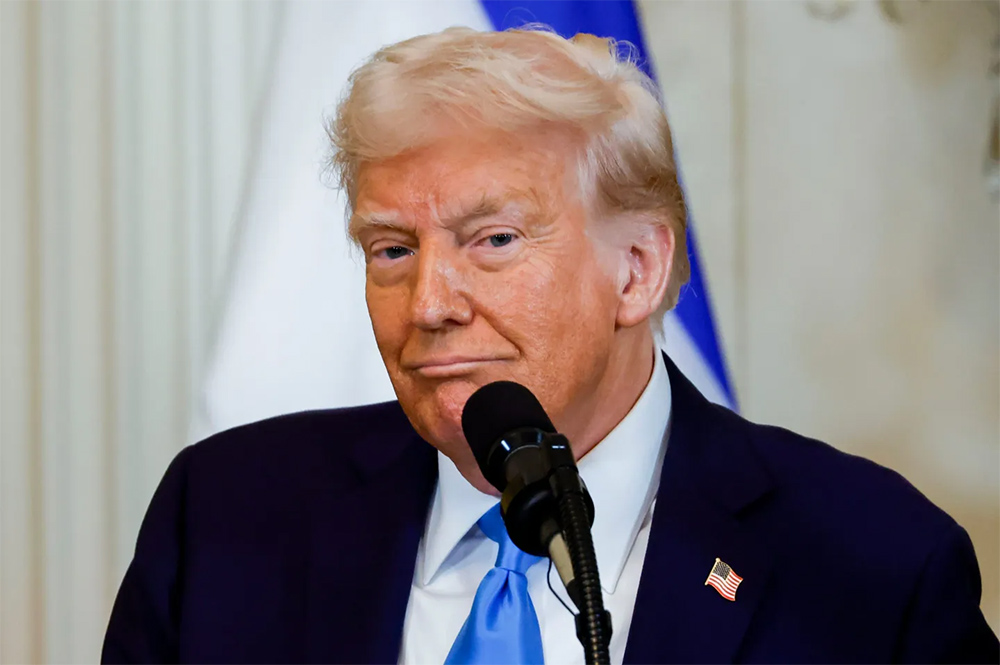
• 埃隆·马斯克和政府效率部的天才团队表示,美国财政部每周向欺诈账户支付约10亿美元。美国总统特朗普对记者表示,这可能有助于削减美国数万亿美元国家债务问题,尽管马斯克所发现的数字,对国家债务的利息而言也只是杯水车薪。
唐纳德·特朗普总统认为,由于欺诈行为的存在,美国36.2万亿美元的国债及相应利息支出的规模,可能远低于官方的估算。
本周末,这位三军统帅在“空军一号”上向记者透露,埃隆·马斯克领导的政府效率部(DOGE)将对“国债”展开调查。国债简称“T-bills”,是公众和投资机构均可购买的政府债券市场的简称。
在前往“超级碗”的专机上,特朗普解释道:“整个国家体系似乎都充斥着欺诈行为,充斥着诈骗、浪费和滥用职权。马斯克和他的天才团队在美国国际开发署(USAID)的发现令人震惊,这还只是冰山一角。”
“接下来我们将调查教育部,你们会发现更严重的同类问题。随后是对军方展开调查,届时将曝光大量腐败现象。这些问题的根源在于政府机构多年来处于失能状态。”
他补充道:“我们甚至开始核查国债本身。国债可能存在……问题。这将是个极具研究价值的发现,因为部分债务可能属于无效账目。换句话说,我们发现的一些问题存在非常严重的欺诈。因此这意味着实际债务规模可能低于现有统计数字。”
特朗普未明确说明其言论针对的是国债证券还是财政部直接支付项目。
然而,当政府效率部负责人马斯克在其拥有的X社交平台上分析欺诈运作机制时,他特别提到了财政部支付的资金。
马斯克上周六发文披露:“昨天,据可靠消息,财政部每年向无社保号(甚至临时身份证号)人员发放的福利金超过1,000亿美元。”
“若该数据属实,情况将极其可疑。当我询问在场财政部官员对此类支付中确凿欺诈金额的估算时,所有人一致认为至少占半数——即每年500亿美元,相当于每周10亿美元!”
“必须立即整顿这种乱象。”
需要说明的是,特斯拉(Tesla)老板马斯克所指的是医疗保险、社会保障等福利性支出,而非低风险的政府债券业务。
在做出此番表态前,马斯克已协同财政部推行系列改革措施。
这些措施包括建立支付分类编码系统提升审计效率;创建包含欺诈主体及已故人员的禁付名单;增设支付事由说明栏以确保支出合理性。
财政部的欺诈行为是新鲜事吗?
个人针对财政部的欺诈行为并非新鲜事,拜登政府期间就已持续开展整治工作。
例如2024年财政部宣布,通过部署人工智能加速识别流程,成功追回40亿美元欺诈性支付。
此类欺诈通常源于信息滞后——以死亡人员账户为例,由于政府未及时获取公民身故信息,导致财政补贴继续发放。
今年1月,财政部测试使用社会保障局完整死亡档案数据库的试点项目,五个月内成功拦截并追回超过3,100万美元的不当支付。
前财政助理部长戴维·莱布里克表示,财政部有能力精准发现无需继续支付的账户,他称这些追回款项只是“冰山一角”。
不过该数字与马斯克指控的500亿美元年度欺诈规模仍存在显著差距。
国债隐忧
从摩根大通(JPMorgan Chase)首席执行官杰米·戴蒙到美联储(Fed)主席杰罗姆·鲍威尔,任何关注美国财政健康的人士都会因为国债方面的潜在好消息而长舒一口气。
这些经济权威人士与其他市场观察家和专家,越来越担忧美国日益增长的财政赤字,特别是随之而来的利息支出。
最令专家警觉的是债务与GDP比率,简单来说,就是美国的债务与经济增长的比率,这代表了美国的偿债能力。
国会预算办公室(Congressional Budget Office,CBO)预测,到2034年国债将激增至50.7万亿美元,相当于GDP的122.4%,
届时,年度利息支出预计将达到1.7万亿美元。
专家警告,若美国经济发展不足以承担债务压力,债权人可能停止购债、要求提高利率或提前收贷——戴蒙将这种风险称为市场“叛乱”。
政策制定者有两种方案,使债务与GDP实现平衡。
首选的方案是通过积极政策刺激经济增长;其次是削减债务,但专家担忧后者将导致公共服务和支持缩水。
马斯克揭露的欺诈问题恰巧提供了双赢的“第三条道路”——在不削减公共服务前提下减少预期支出。
然而,尽管每年500亿美元的追缴额度惊人,但相较美国2023年净利息支出(最新可用数据)6,580亿美元,该数额仍是杯水车薪。(财富中文网)
译者:刘进龙
审校:汪皓
• 埃隆·马斯克和政府效率部的天才团队表示,美国财政部每周向欺诈账户支付约10亿美元。美国总统特朗普对记者表示,这可能有助于削减美国数万亿美元国家债务问题,尽管马斯克所发现的数字,对国家债务的利息而言也只是杯水车薪。
唐纳德·特朗普总统认为,由于欺诈行为的存在,美国36.2万亿美元的国债及相应利息支出的规模,可能远低于官方的估算。
本周末,这位三军统帅在“空军一号”上向记者透露,埃隆·马斯克领导的政府效率部(DOGE)将对“国债”展开调查。国债简称“T-bills”,是公众和投资机构均可购买的政府债券市场的简称。
在前往“超级碗”的专机上,特朗普解释道:“整个国家体系似乎都充斥着欺诈行为,充斥着诈骗、浪费和滥用职权。马斯克和他的天才团队在美国国际开发署(USAID)的发现令人震惊,这还只是冰山一角。”
“接下来我们将调查教育部,你们会发现更严重的同类问题。随后是对军方展开调查,届时将曝光大量腐败现象。这些问题的根源在于政府机构多年来处于失能状态。”
他补充道:“我们甚至开始核查国债本身。国债可能存在……问题。这将是个极具研究价值的发现,因为部分债务可能属于无效账目。换句话说,我们发现的一些问题存在非常严重的欺诈。因此这意味着实际债务规模可能低于现有统计数字。”
特朗普未明确说明其言论针对的是国债证券还是财政部直接支付项目。
然而,当政府效率部负责人马斯克在其拥有的X社交平台上分析欺诈运作机制时,他特别提到了财政部支付的资金。
马斯克上周六发文披露:“昨天,据可靠消息,财政部每年向无社保号(甚至临时身份证号)人员发放的福利金超过1,000亿美元。”
“若该数据属实,情况将极其可疑。当我询问在场财政部官员对此类支付中确凿欺诈金额的估算时,所有人一致认为至少占半数——即每年500亿美元,相当于每周10亿美元!”
“必须立即整顿这种乱象。”
需要说明的是,特斯拉(Tesla)老板马斯克所指的是医疗保险、社会保障等福利性支出,而非低风险的政府债券业务。
在做出此番表态前,马斯克已协同财政部推行系列改革措施。
这些措施包括建立支付分类编码系统提升审计效率;创建包含欺诈主体及已故人员的禁付名单;增设支付事由说明栏以确保支出合理性。
财政部的欺诈行为是新鲜事吗?
个人针对财政部的欺诈行为并非新鲜事,拜登政府期间就已持续开展整治工作。
例如2024年财政部宣布,通过部署人工智能加速识别流程,成功追回40亿美元欺诈性支付。
此类欺诈通常源于信息滞后——以死亡人员账户为例,由于政府未及时获取公民身故信息,导致财政补贴继续发放。
今年1月,财政部测试使用社会保障局完整死亡档案数据库的试点项目,五个月内成功拦截并追回超过3,100万美元的不当支付。
前财政助理部长戴维·莱布里克表示,财政部有能力精准发现无需继续支付的账户,他称这些追回款项只是“冰山一角”。
不过该数字与马斯克指控的500亿美元年度欺诈规模仍存在显著差距。
国债隐忧
从摩根大通(JPMorgan Chase)首席执行官杰米·戴蒙到美联储(Fed)主席杰罗姆·鲍威尔,任何关注美国财政健康的人士都会因为国债方面的潜在好消息而长舒一口气。
这些经济权威人士与其他市场观察家和专家,越来越担忧美国日益增长的财政赤字,特别是随之而来的利息支出。
最令专家警觉的是债务与GDP比率,简单来说,就是美国的债务与经济增长的比率,这代表了美国的偿债能力。
国会预算办公室(Congressional Budget Office,CBO)预测,到2034年国债将激增至50.7万亿美元,相当于GDP的122.4%,
届时,年度利息支出预计将达到1.7万亿美元。
专家警告,若美国经济发展不足以承担债务压力,债权人可能停止购债、要求提高利率或提前收贷——戴蒙将这种风险称为市场“叛乱”。
政策制定者有两种方案,使债务与GDP实现平衡。
首选的方案是通过积极政策刺激经济增长;其次是削减债务,但专家担忧后者将导致公共服务和支持缩水。
马斯克揭露的欺诈问题恰巧提供了双赢的“第三条道路”——在不削减公共服务前提下减少预期支出。
然而,尽管每年500亿美元的追缴额度惊人,但相较美国2023年净利息支出(最新可用数据)6,580亿美元,该数额仍是杯水车薪。(财富中文网)
译者:刘进龙
审校:汪皓
• Elon Musk and his band of “geniuses” at DOGE say there could be some $1 billion a week being paid out by the Treasury to fraudulent accounts. President Trump told reporters this could tip the scales in America’s multitrillion national debt headache, though Musk’s figure is only a fraction of interest payments alone.
President Donald Trump believes America’s $36.2 trillion national debt—and its corresponding interest payments—might actually be smaller than estimated owing to fraud.
The commander in chief told reporters on board Air Force One this weekend that Elon Musk’s Department of Government Efficiency (DOGE) will investigate “Treasuries,” also known as T-bills—market shorthand for government debt securities that can be purchased by members of the public and investment vehicles.
Speaking en route to the Super Bowl, Trump explained: “The whole country looks like it’s a fraud. It’s fraud, waste, abuse. What Elon and his group of geniuses have found is unbelievable—and that’s just in USAID.
“Soon we’re going into education—you’ll find the same thing but bigger. Soon we’re going into the military, and you’re going to find a lot of bad things happening there. You’ll find it because our government hasn’t functioned properly for many many years.”
He continued: “We’re even looking at Treasuries. There could be a problem … with Treasuries. And that could be an interesting problem because it could be that a lot of those things don’t count. In other words, that some of that stuff that we’re finding is very fraudulent. Therefore, maybe we have less debt than we thought of.”
President Trump did not specify whether he was referring to T-bills or government payments made via the Treasury Department.
However, when DOGE boss Musk took to X—the social media platform he owns—to share how he believes such fraud is taking place, he referred to payments handed out by the Treasury.
“Yesterday, I was told that there are currently over $100B/year of entitlements payments to individuals with no [Social Security number] or even a temporary ID number,” Musk posted on Saturday.
“If accurate, this is extremely suspicious. When I asked if anyone at Treasury had a rough guess for what percentage of that number is unequivocal and obvious fraud, the consensus in the room was about half, so $50B/year or $1B/week!!
“This is utterly insane and must be addressed immediately.”
As such, the Tesla boss refers to “entitlement” payments—such as Medicare and Social Security—and not low-risk government debt bonds.
Musk made this point after outlining a raft of measures he has introduced alongside the Treasury.
These include introducing categorization codes for payments to make auditing more straightforward; a do-not-pay list of entities which are fraudulent, or related to deceased individuals; and the launch of a “rationale field” for payments so that the spending can be justified.
Is Treasury fraud a new phenomenon?
Individuals committing fraud against the Treasury is not new; work continued to redress the issue under the Biden administration.
In 2024, for example, the Treasury announced it had recovered $4 billion in fraudulent payments by deploying AI to expedite the identification process.
Fraud can occur, for example, when the government isn’t informed that an individual has died. As such, erroneous payments to this person may continue after their death.
In January, the Treasury Department announced it prevented and recovered more than $31 million in five months after it tested a pilot using the Social Security Administration’s Full Death Master File.
As such, the department could pinpoint which accounts it should no longer pay into, with the millions of dollars recovered described by former fiscal assistant secretary David Lebryk as the “tip of the iceberg.”
However, these figures are still some way below the $50 billion in fraud alleged by Musk.
National debt concerns
Some potentially positive news on national debt will be a relief for everyone from JPMorgan Chase CEO Jamie Dimon to Fed Chairman Jerome Powell.
The economy veterans, along with a host of other market watchers and experts, have become increasingly concerned by Uncle Sam’s growing deficit and, more important, the interest payments that accompany it.
Experts are most alarmed by America’s debt-to-GDP ratio. Simply put, the money it owes versus the growth of the economy and hence, its ability to service its debt.
The Congressional Budget Office (CBO), for example, estimates that national debt will balloon to $50.7 trillion—122.4% of GDP—in 2034.
As such, interest payments are expected to sit at around $1.7 trillion by that same year.
Experts fear that if America’s economy does not remain strong enough to foot the bills it is racking up, at some point, lenders will stop buying the debt, will begin asking for higher interest payments, or will call in their loans—a market “rebellion” as Dimon phrases it.
Policymakers have two options to bring this balance of debt and GDP back into line.
The first—and widely preferred choice—is to grow the economy through progressive policies. The second would be to cut debt, which experts worry would include axing public services and support.
Musk’s apparent uncovering of fraud presents a win-win situation: reducing expected payments without cutting public services.
However, while $50 billion a year in savings is an eye-watering amount, it is still a fraction even of the net interest costs America paid out in 2023 (the latest available data), which totaled $658 billion.






